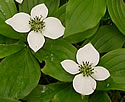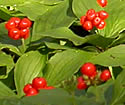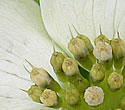Cornus canadensis (Bunchberry)
| Also known as: | Bunchberry Dogwood, Creeping Dogwood |
|---|---|
| Genus: | Cornus |
| Family: | Cornaceae (Dogwood) |
| Life cycle: | perennial |
| Origin: | native |
| Habitat: | part shade, shade; acidic soil; moist woods, bogs |
| Bloom season: | May - July |
| Plant height: | 4 to 8 inches |
| Wetland Indicator Status: | GP: FACU MW: FAC NCNE: FAC |
| MN county distribution (click map to enlarge): |  |
| National distribution (click map to enlarge): |  |
Pick an image for a larger view. See the glossary for icon descriptions.
Detailed Information
Flower: 

![[photo of flowers]](/udata/r9ndp23q/pd/cornus-canadensis-002-t.jpg) A single cluster of tiny greenish to creamy white stalked flowers in the center of four large white bracts that look like petals. Flowers have 4 creamy yellow stamens and a dark, reddish brown style in the center. The bracts are broadly oval, tapered to a soft point; typically one pair of opposite bracts is slightly larger than the other pair. The cluster, including bracts, is about ¾ to 1 inch across with a single cluster at the top of the stem.
A single cluster of tiny greenish to creamy white stalked flowers in the center of four large white bracts that look like petals. Flowers have 4 creamy yellow stamens and a dark, reddish brown style in the center. The bracts are broadly oval, tapered to a soft point; typically one pair of opposite bracts is slightly larger than the other pair. The cluster, including bracts, is about ¾ to 1 inch across with a single cluster at the top of the stem.
Leaves and stem: 


![[photo of leaves]](/udata/r9ndp23q/pd/cornus-canadensis-007-t.jpg) 2 or 3 pairs of leaves, appearing as a whorl of 4 or 6 leaves, is just below the flower cluster, with a few pairs of small to scale-like opposite leaves along the lower stem. Leaves are broadly elliptic to diamond-shaped, 1½ to 3 inches long, toothless, sometimes wavy around the edges, tapered to a soft point at the tip, tapering at the base to a short stalk. 2 to 3 pairs of laterals veins arise from the base end of the
midvein. Surfaces are variably covered in appressed hairs though may become smooth. Usually if whorled in 4s they are all of similar size; if 6, one opposite pair is slightly larger than the other 2 pairs. Stems are unbranched, arsing from creeping woody rhizomes on the ground.
2 or 3 pairs of leaves, appearing as a whorl of 4 or 6 leaves, is just below the flower cluster, with a few pairs of small to scale-like opposite leaves along the lower stem. Leaves are broadly elliptic to diamond-shaped, 1½ to 3 inches long, toothless, sometimes wavy around the edges, tapered to a soft point at the tip, tapering at the base to a short stalk. 2 to 3 pairs of laterals veins arise from the base end of the
midvein. Surfaces are variably covered in appressed hairs though may become smooth. Usually if whorled in 4s they are all of similar size; if 6, one opposite pair is slightly larger than the other 2 pairs. Stems are unbranched, arsing from creeping woody rhizomes on the ground.
Fruit: 
![[photo of fruit]](/udata/r9ndp23q/pd/cornus-canadensis_1423-4-t.jpg) Fruit is a round berry about 3/16 inch across that ripens to bright red.
Fruit is a round berry about 3/16 inch across that ripens to bright red.
Notes:
A species of cool, moist woods and bogs, Bunchberry's woody rhizomes can form large dense colonies in northern boreal forests that—both in flower or in fruit—produce stunning arrays.Native Plant Nurseries, Restoration and Landscaping Services ↓
More photos
Photos courtesy Peter M. Dziuk taken in Aitkin, Cass and St. Louis counties.
Comments
Have you seen this plant in Minnesota, or have any other comments about it?
on: 2011-06-18 12:04:49
Saw this flower in a small colony a drive yesterday. 6/18/2011. It was a new one to me and I am so glad I was able to identify it.
on: 2011-06-24 22:55:17
We were hiking in the park last week (6-21-11) and saw carpets of these in the understory along the trail. They were gorgeous, and I used your site to identify them. Excellent images, so thank you!
on: 2011-06-26 00:53:40
Beautiful in the undergrowth at the Wellstone Memorial site.
on: 2011-07-01 07:54:39
The flower provides prolific groundcover in the North Woods.
on: 2011-07-07 14:18:47
I've been searching wildflower sites since I bought my place off Lake Superior 5 years ago. A large portion of my property was largely cleared by the previous owner, so I wanted to make sure that native plants took hold as it re-vegetated. Every year I had heaps of invasive plants (don't have the names at hand) that I pulled up, but I'm glad to say, my place is filling in with all sorts of beautiful native (or cohesive) varieties. Dogwood, Asters,Yarrow, and Indian grass. Also, I just identified what I thought was Indian brush as Hawks weed, and now I have found through your site what that broad leaf plant that seems to thrive in the small clearings in the woods. Grateful to have found this site. It is now bookmarked!
on: 2012-05-28 16:17:55
We spotted these very striking plants in a red pine forest in the Chippewa National Forest.
on: 2012-05-30 17:49:12
I saw many of these on the hiking trail to the lower falls in Grand Portage. Your site helped me to identify them.
on: 2013-07-31 13:39:15
These are such beautiful plants. I had to know what they were. Had to go elsewhere to ID because it had berries when I saw them, but after I knew the name came here to verify info. I am told the berries make good jelly.
on: 2016-04-14 15:18:54
Lester River Park - on higher ground.
on: 2016-09-09 19:55:03
I was surprised to find a Bunchberry bloom so late in the season, growing right next to another Bunchberry plant that had gone to fruit and lost its berries. Not sure if that happens often but I thought it was interesting.
on: 2016-09-09 21:59:50
Janet, many spring blooming plants respond to a combination of temperature and amount of daylight. When conditions are right they can bloom again later in the season.
on: 2017-06-03 14:43:21
I found a plant very similar to this in almost all ways, except that the leaves are certainly hairy. With minute fine hairs covering the leaves. I don't see a species like that on your website. Any idea what it is? I found it along Split Rock Creek.
on: 2017-06-22 10:46:04
Saw these 6/20/17, all along trail to Devil's Kettle, as well as in Grand Marais by Artist's Point.
on: 2018-07-24 08:18:25
These are plentiful on the forest floor, all along the trails, in Banning State Park in the early spring. The forest floor is covered with thick colonies. They even grow up against the sandstone blocks left exposed after the quarry operations ended decades ago.
on: 2019-06-09 10:59:14
Is the fruit edible? Just curious. I have lots growing in the woods surrounding my yard.
on: 2019-06-09 14:49:33
Cindy, according to Plants for a Future, the fruit is edible but not necessarily all that tasty.
on: 2019-06-15 08:36:34
They were in full bloom and gorgeous throughout the state park!
on: 2019-06-22 15:43:15
Prolific along ditch behind row of mailboxes Beautiful
on: 2019-07-18 21:27:51
Saw bunchberries in the woods, but could not think of the name. After two days of thinking about it, checked your site. Your helpful categories for describing a plant told me exactly what I wanted to know! Thank you!
on: 2020-06-07 03:51:08
By the swinging bridge
on: 2020-06-08 09:04:07
Can you tell me where I can get bunchberry plants?
on: 2020-06-08 09:17:04
Kathy, we don't track who sells what. See "Where to buy native seeds and plants" that is shown on most pages of the website. If none of those vendors carry it one may know who does.
on: 2021-08-13 21:43:44
Along the hiking trails at Split Rock State Park. They're gorgeous.
on: 2021-09-04 12:46:20
Can I plant Bunchberry seeds in the fall? Any special techniques? I bought a couple packs from https://www.createdbynature.com/. Also, may be able to get Bunchberry plants from Prairie Restorations, https://www.prairieresto.com/ in the spring.
on: 2021-09-04 15:39:23
Elizabeth, you should consult with whomever sold you the seeds. Planting instructions are also usually on the seed packs. Having said that, many native plants require over-wintering before they'll germinate so fall or winter is the best time to sow seeds.
on: 2023-02-23 14:50:51
Always look forward to finding these in my woods. Flower the end of May.







 a colony of Bunchberry in flower
a colony of Bunchberry in flower a colony of Bunchberry in fruit
a colony of Bunchberry in fruit  budding flowers
budding flowers